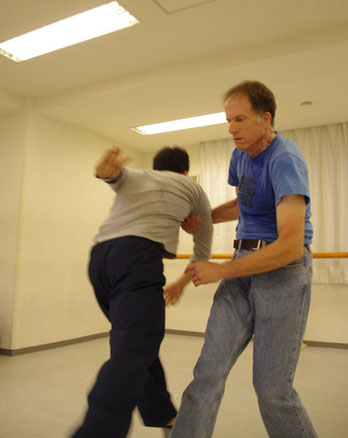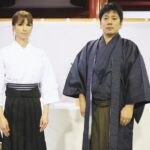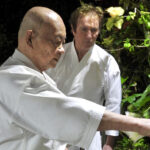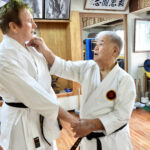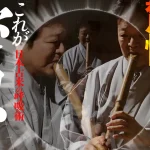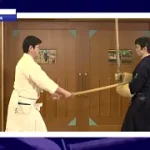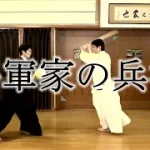Text and Photo by Scott Meredith
Introduction

The Chinese martial art Taijiquan, when properly understood, is a martial art like no other. Its fundamental principle contradicts all our natural intuitions. Our natural intuitions about physical power in fighting have been well stated in the Classic Writings of Taijiquan:
“There are many fighting arts. Although they take different forms, they generally don’t go beyond the strong dominating the weak, and the slow losing to the swift. But strength and speed are natural physical endowments, not the result of superior understanding. As for strength, it’s been said that “Four ounces can neutralize a thousand pounds” ? so physical force may not be the ultimate trump card. And when we hear of an old man defeating a gang of youngsters, can we honestly conclude that this is due to speedy reflexes?”
– Wang Zongyue
My Taijiquan is in the lineage of Professor Zheng Manqing (1902 – 1975), as transmitted by Benjamin Lo of San Francisco. This style is based on the Asian theory that a semi-physical or non-physical power lies dormant in the human body and mind. Through centuries of conflict, this power has been harnessed, refined, amplified, and deployed for self-defense and martial arts. Nowadays, because guns are widespread, the combative focus of classical Taijiquan training is no longer paramount. The emphasis has shifted to the enjoyable and fascinating inner experiences that result from the cultivation and direct perception of this internal force.
The most important requirement for Taijiquan training is relaxation. You must never tense up or attempt to use muscular force, either in solo practice or in handling a training partner or actual adversary. That seems counter-intuitive. How can anything be done without physical force? Taijiquan theory maintains that although a very soft physical ‘nudge’ may be used as a kind of trigger, the startling physical effects that a Taijiquan adept can demonstrate do not result from ordinary physical power.
The power source can be compared to making popcorn. When the heat from the fire reaches a certain level, it triggers an explosive movement and sound from the popcorn kernel. However, the heat is only the triggering agent. The pop is actually powered by the stored chemical energy within the popcorn kernel itself. No matter how much you heat a soybean, you won’t get this result. So, your partner’s body is actually being moved by his or her own inner tension, which is merely triggered by your light push. So the first work of Taijiquan is mental ? to shed the lifelong automatic association of power with physical force and muscles.
Soft Power
Taijiquan practice is based on a sequence of slow-motion postures. The sequence is performed solo, like shadow-boxing. The posture work is beyond the scope of this brief introductory article. I’ll discuss instead the other primary training method of Taijiquan – working with a partner in the Push Hands drill.
In the Push Hands drill, two partners face one another and each attempts to unbalance the other with a light push or pull. It is cooperative because we follow rules against striking, sweeping, throwing, and kicking. Yet it is non-compliant because it has ‘aliveness’ ? we don’t play along for the sake of social pleasantry. Only when our partner exploits genuine tension in our bodies must we take a step to regain our balance. This keeps the practice ‘real enough’, so that something of value can be learned. It is akin to a limited version of the traditional Japanese jujutsu practice of kuzushi(崩し : collapsing, unbalancing, or taking down).
It sounds simple on the physical level, but this drill has some interesting elements of the deeper Taijiquan philosophy. Foremost of those is relaxation. Habitual tension carried in your body, and/or any attempt to use crude muscular force can be easily detected and nullified by a skilled partner. So you must avoid those two faults, of inherent tension and use of force, no matter how long it takes to shed them.
Furthermore, many Taijiquan traditions teach techniques for physical manipulation of the partner’s body and joints, organized as a syllabus of ‘attacks’ and ‘defenses’. My tradition, however, does not employ techniques. That’s because there’s too much ground to cover, as the range of possible moves and counter-moves is endless. Instead, we work on the level of higher principle, because if our energy is sensitive enough, it will alert us in time to pre-empt and neutralize any kind of movement from our partner
‘Unbalancing’ the partner means forcing him or her to take one or more steps to regain stability. It generally isn’t necessary to hurl the partner several meters away, or to throw him hard against a wall. It’s sufficient to use a soft touch to shake the partner’s balance just enough to force a step out, or two. This keeps the practice safe and fun, as well as allowing for cultivation of a finely calibrated force that is under very rigorous control.
Shadowing
More important than the final motion of actual unbalancing is the concept of shadowing. I mentioned shadowboxing above, in connection with the solo Taijiquan form training. But in push hands practice, shadowing means to adhere lightly to the partner’s arms or body no matter how he or she moves. And just as it’s impossible to outrun or disconnect your body from your own shadow in the sunlight, it should be impossible for your partner to make any move that you haven’t already anticipated and pre-figured.
In this way, your partner’s power will never find any stable or ‘stuck’ point to which it can be effectively applied. So, rather than being a struggle of strength against strength, or spectacle of clever technique, Professor Zheng’s Taijiquan Push Hands drill is a playpen where the amazing, counter-intuitive principle of Taijiquan ? that four ounces may defeat a thousand pounds ? can be investigated and proven. Naturally, if both partners never use any force at all, neither will ever find any tension to which even four ounces can be applied. But although this is true in theory, in real life you’ll usually find that you and your partner will tend to bring excess tension to the encounter, from which both of you can learn.
Combative Realism?
Always remember that the push hands drill isn’t a fight. A fighting mentality introduces an ugly element of danger and a psychology of either pride or fear (depending on how dominant you think you are). More importantly, a combative or competitive mind will actually hinder development of the inner power which is the real goal of the drill. It’s essential to maintain a serious overall goal of improving one’s skill, but to keep a light and playful attitude while actually engaging in the practice.
We do not view push hands as a sport. Our school doesn’t emphasize push-hands tournaments, because our goals are different. In a sport, only one thing matters: winning. That’s fine for sports but for internal development, the need to win can blunt our sensitivity to subtle clues which arise in the interaction. These clues, if noticed and nurtured, can evolve into major advancements. During a session, we are more interested in ‘working’ than in ‘winning’.
That said, however, it’s true that Taijiquan was once viewed as a combative discipline, and it’s interesting to examine push hands in that light. One element that’s often misunderstood is the requirement that you must keep your feet stationary. Being forced to move a foot (to maintain balance), or deliberately taking a step (to better position yourself to push out your partner), are considered faults.
This principle has led to a lot of mis-understanding. Outside the Taijiquan world, the idea of keeping one’s feet stationary in a quasi-martial drill seems ludicrous. Movement is the first principle of any martial art or combat sport. Isn’t it absurd to hardwire-in such a wrong-headed limitation? Also, within the Taijiquan world, the emphasis on keeping the feet stationary sometimes leads to another fallacy ? an over-emphasis on ‘rooting’.
As for the first concern about the realism vs. artificiality of stationary feet, we remember that push hands is not a fight, nor does it seek to directly develop a fighting skill or techniques. It is an attribute drill ? seeking to nurture the expression of internal power, which can be used for many purposes, or simply for the wonder and pleasure of doing it ? as art for art’s sake. We can compare push hands to the lowly pushup exercise. Pushups are not directly combative at all, yet the US Marine Corps and Navy SEAL teams and others constantly perform them for physical and mental toughness. That’s attribute development. So, as an attribute drill, there’s no great harm in the stationary foot requirement.
Furthermore, the stationary foot requirement is fundamental to the drill’s purpose. If, in defense, you can always step away from incoming force, and, in offense, you can step into mechanically advantaged positions, your body will never acquire the necessary sensitivity and refined perception to really master the art.
The Rooting Mistake
Now, what about the other fallacy from the Taijiquan side itself, the over-emphasis on rooting? The stationary foot rule has led many people to believe that the highest Taijiquan skill is to be able to ‘stand like a mountain’ so that no matter how much strength is applied to you, you not only don’t move your feet. You don’t move at all. A master of rooting will just stand in place and brace himself against an applied force, like an American football linebacker.
But this is as misguided a practice as the opposite extreme (routinely stepping out of the incoming force). That’s because bracing generally induces physical tension. But relaxation is the prime directive of Taijiquan. It’s better to spend most of your training time working on the signature elements of Taijiquan, such as relaxation and yielding. Yielding is when you use your relaxation to lightly adhere to your partner no matter how he moves.
The stationary foot requirement underlies the two principles of the push hands drill:
- i. You must remove all tension from your own body, giving your partner’s power no place to focus.
- ii. You must exploit any ripple or zone of tension you detect in your partner’s body, using it as a lever or handle to unbalance him or her.
You learn to do these two things by attempting to shadow, or follow perfectly your partner’s every movement without lagging or anticipating.
Many schools of Taijiquan emphasize push hands choreography. In those drills, the partners engage in a pre-set pattern of movements, continually cycling through postures of offense and defense. This may be a good warmup for the joints but it can never teach the spontaneous sensitivity to sudden force that the freestyle method develops.
The Drills
In this section I’ll introduce and comment on some specifics of Push Hands, and present a few special restrictions that can enliven the game. The photos used here are extracted from video of authentic push hands work. It isn’t staged for the photographer. My partner is a highly skilled and experienced mixed martial artist, who also outweighs me (69 kg vs. 65 kg). He’s really trying to slam me down in these photos. I am using only about 5% of my available Taiji power because it’s too dangerous to push him more forcefully in a room without floor mats and wall pads.
The following five Push Hands modes will be discussed and illustrated:
- Equal Freestyle
- Single Hand vs. Double Hands
- Upright Stance vs. Fully Braced Stance
- Bound Arms vs. Free Arms
- Stationary Feet vs. Moving Feet
Equal Freestyle
There are a number of formats for push hands. One setup is to allow equal freedom to both partners in their movements and responses, both for offense and defense. In the photo sequence below, which was extracted from a video of real unscripted practice, my partner is first shown attempting to push me down:
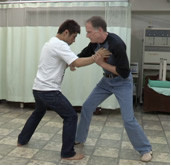
I neutralize his force:
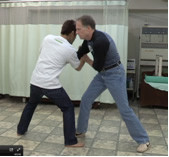
I then slip in and apply an unbalancing push:
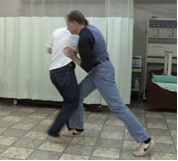
My partner is launched some distance away:
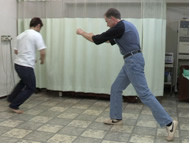
The sequence above illustrates a typical push hands interaction. However, it can be helpful to impose various limitations and handicaps on one player (the players can take turns assuming the restrictions). These physical restrictions limit the body’s range of permitted motions or actions in some way. Restrictions on physical performance reduce reliance on ordinary strength and structural advantages. The restricted partner is forced to rely on sensitivity and the soft art of pre-emption via attentive shadowing. Restrictions also reduce the encumbered partner’s ability to bring clever techniques to the situation. The only goal of push hands is to help us master the body’s internal power. Techniques are absolutely irrelevant to this purpose.
Restriction #1: Single Hand vs. Double Hands
An obvious handicap is to restrict one partner to using only a single hand for defense and offense, while the other partner can use both hands in the normal way. Have one partner tuck his back hand into his rear belt to keep it out of the way. The other partner keeps both hands free as in the standard configuration.
My partner attempts to move me using both his hands:

I respond with a light single-hand push:
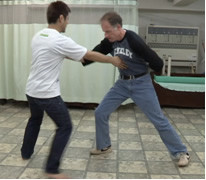
Which unbalances him, nudging him backwards:
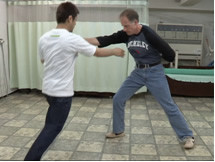
Restriction #2: Upright Stance vs. Fully Braced Stance
Another way to impair one partner’s stability is to have him give up the typical low, strongly braced, and guarded stance of most Push Hands practice. In this mode, one partner is required to stand upright in a normal stance, like waiting for a bus. The upright partner must be very sensitive to keep from being pushed over in this stance. This limitation is also more closely related to realistic self-defense scenarios.
We begin with my partner in fully braced stance, against me standing upright in no special stance:
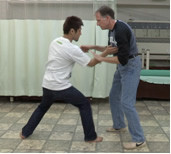
As he pushes me, I neutralize his incoming force as usual:
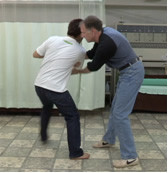
I then apply an unbalancing push:
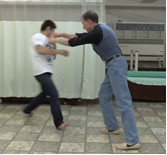
My partner is thrown some distance away:

Restriction #3: Bound Arms vs. Free Arms
If one partner’s arms are tied to his body, his options for the use of ordinary strength and technique are severely curtailed. A karate belt is used to tie one partner’s arms just above the elbow tightly to his sides. This removes the temptation to bring excessive straight-arm shoving to the game. Internal power may manifest physically – but it isn’t based on body mechanics. It is issued from the feet, and it travels through the body and out via the arms and hands. It is not dependent on vigorous arm gestures or use of muscles.
Here, my partner with free arms attempts to push me as usual:
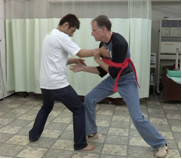
Even with bound arms, I neutralize his incoming power in the normal way:

I then apply a light push to his body:

The push moves him a meter or so distance:

Restriction #4: Stationary Feet vs. Moving Feet
Another option is to allow one partner the freedom to move around both to get better attack position, or to resist being pushed out. In the sequence below, I will keep my feet stationary while my partner is free to move around.
Below, my partner uses his freedom of foot movement to attack from the outside, while stepping in to me:
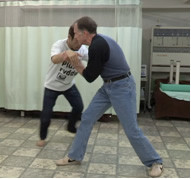
I immediately neutralize and counter-push. Despite having freedom to step, he loses his balance:

And with a light push once again he’s thrown some distance away:
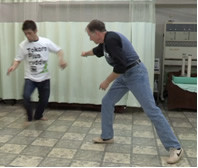
Additionally, any two or more of the restrictions above can be combined for further interesting variations. And many other configurations are possible – it’s limited only by your imagination.
Conclusion
This article has described a training method that is unique to one school and lineage of Taijiquan. But the internal power has been recognized and mastered by special individuals of all times and places. In the Japanese context, it’s appropriate to mention the great master of Daitouryuu Jujutsu, Sagawa Yukiyoshi. Though the superficial practice methods of Daitouryuu and Taijiquan appear to differ radically, it’s obvious that the power referred to by Sagawa Sensei is what we are using in Taijiquan.
Some quotations from the teachings of Sagawa Sensei make this parallelism abundantly obvious. Any of the Sagawa teachings below could have been taken directly from the mouth of any number of Taijiquan masters in our lineage, e.g. the famous teacher Yang Chengfu. The quotations are from the book 透明な力 by Professor Kimura Tatsuo.
身体の力を全く抜いているから敵の弱い点がすぐ分かるのです。敵の力に逆らわない。
When you absolutely eliminate all strength from your body, you will instantly realize your opponent’s weak spots. Do not oppose your opponent’s power.
本当の合気はゆっくり静かに倒すのだ。
The real Aiki power unbalances the opponent softly and quietly.
稽古はくり返す事によって正しい事を習慣づけ体にしみ込ませようというわけだから倒す事ばかりに夢中になっているとりきむ習慣や悪いくせが体にしみ込んでしまう。
It takes a long period of repeated practice to imbue your body with the ability to do kuzushi correctly. If you get too hung up on just winning the encounter, you’ll pick up the bad habit of relying on tense physical strength.
足腰のできていない人は肩の力に頼るようになってしまう。柔らかい動きをする人は上手くなる可能性があるのだが、りきんでかたい人は、もうそこでダメになってしまう。
People who haven’t prepared their lower bodies properly will end up relying on shoulder strength. Only people who practice soft movement have the potential to become skilled. People who tense up and use strength are hopeless.
In conclusion, that phrase in Sagawa’s quotation just above can be taken as a perfect summary of Taijiquan’s methods and goal: soft movement.
